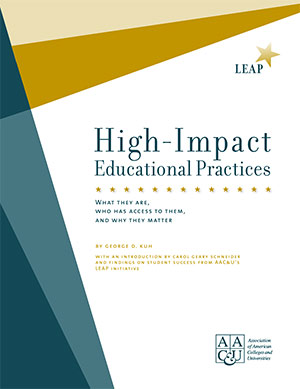High Impact Practices (HIPs)
 Instructors have hundreds of teaching practices, methods, strategies, activities and tools for teaching. Some of these practices work best in a specific discipline (often called signature pedagogies). Some of these teaching practices work best for a given teaching situation. Other practices might work for students at specific development or learning levels. And some practices might suit the teaching style of an instructor.
Instructors have hundreds of teaching practices, methods, strategies, activities and tools for teaching. Some of these practices work best in a specific discipline (often called signature pedagogies). Some of these teaching practices work best for a given teaching situation. Other practices might work for students at specific development or learning levels. And some practices might suit the teaching style of an instructor.
Extensive research has established that some teaching practices have a higher impact than others in that they lead to deeper approaches to learning. Using a deeper approach to learning means that “students who use these approaches tend to earn higher grades and retain, integrate and transfer information at higher rates” (Kuh, 2008). Instructors should pay attention to these evidence-based practices because they are shown to get a higher rate of engagement, persistence, and academic achievements.
These practices are called high impact practices (HIPs). Originally 10 in number, but updated in 2013 to include one more, there are now 11 specific and high impact teaching and learning practices that instructors can incorporate into any course or program. Multiple HIPs can be incorporated into one course or can be contained within one activity in a course or an entire course can be designed around a practice.
HIPs are “techniques and designs for teaching and learning that have proven to be beneficial for student engagement and successful learning among students from many backgrounds. Through intentional program design and advanced pedagogy, these types of practices can enhance student learning and work to narrow gaps in achievement across student populations.”
These practices are called high impact because they have extensive research shown to improve student success particularly in enhanced academic achievements, engagement in educationally purposeful activities, increase student satisfaction and contribute to greater persistence and retention rates in courses and programs. HIPs also have been shown to increase the participation rate of underrepresented students (e.g., Indigenous, gender-diverse, students with disabilities, economically disadvantaged students, etc.) Many of these practices work in any discipline or subject area regardless of size or location of the institution.
George Kuh, founding director of the National Survey of Student Engagement (NSSE), found 10 practices through his research on student engagement. The NSSE survey still is offered in the US and Canada for institutions to be a part of — including Vancouver Island University. See their report and comparison to other BC institutions on the key HIPs.
His seminal report written in 2008, “High-Impact Educational Practices: What They Are, Who Has Access to Them and Why They Matter, outlines the HIPs and their essential components. In 2016, Kuh added an 11th practice — ePortfolios.
11 High Impact Practices
| 1. First-year seminars | 2. Common intellectual experiences (core curriculum) | 3. Learning communities | 4. Writing-intensive courses |
| 5. Collaborative assignments and projects | 6. Undergraduate research opportunities | 7. Diversity-oriented and globally focused learning | 8. Service learning and community-based learning |
| 9. Internships /co-op /practicum | 10. Capstone courses/projects | 11. Digital or e‑portfolios |
All 11 of these practices share some key elements that contribute to deeper learning. Kuh, O’Donnell and Schneider (2017) identified eight key elements common among all the high-impact practices.
Common Elements
- High Level: student’s performance expectations are set at an appropriately high level
- Interactive: require meaning interactions with instructors and peers, opportunities to build relationships, provides mentorship and allows for sharing of intellectual interests on an ongoing basis in or out of the classroom
- Effortful: require significant student time and effort to foster an investment and commitment to course, program or institution over an extended period of time
- Rich and Frequent Feedback: allow for frequent, timely and constructive feedback — so students can see their progress and success
- Application: provide an opportunity for the application of knowledge and skills in different environments particularly ‘real world’ — using acquired knowledge in different settings gives meaning and value to learning experiences
- Public Demonstrations: students must demonstrate their competence publicly
- Explore Diversity: students explore cultures, life experiences and worldviews different than their own
- Reflection: students are provided with periodic, intentions and structured opportunities for personal reflections — reflecting on learning experiences can increase a student’s awareness of their own beliefs and assumptions